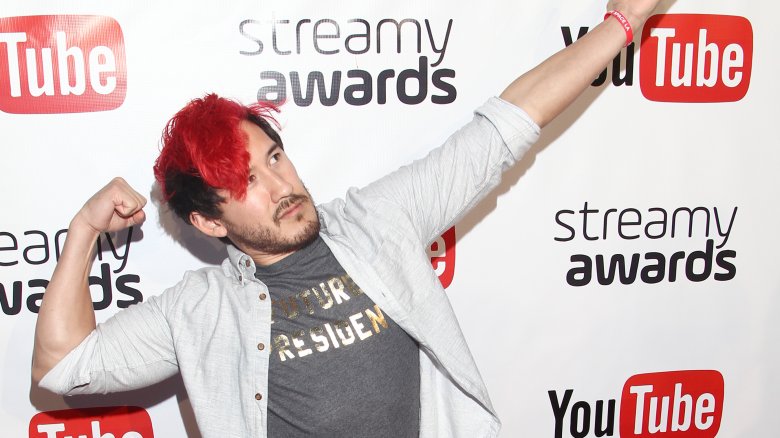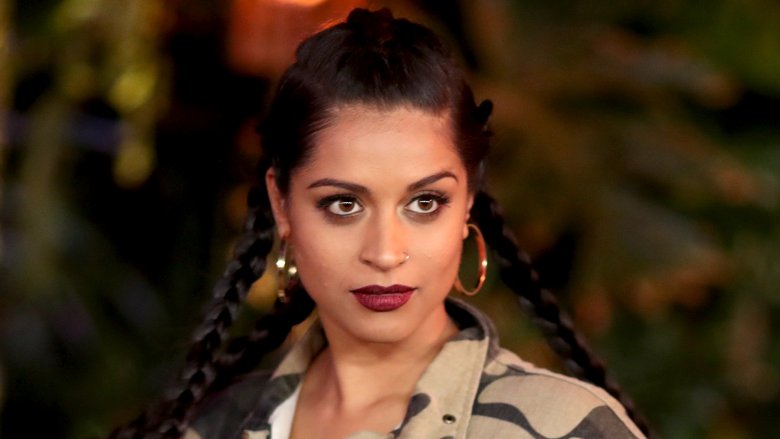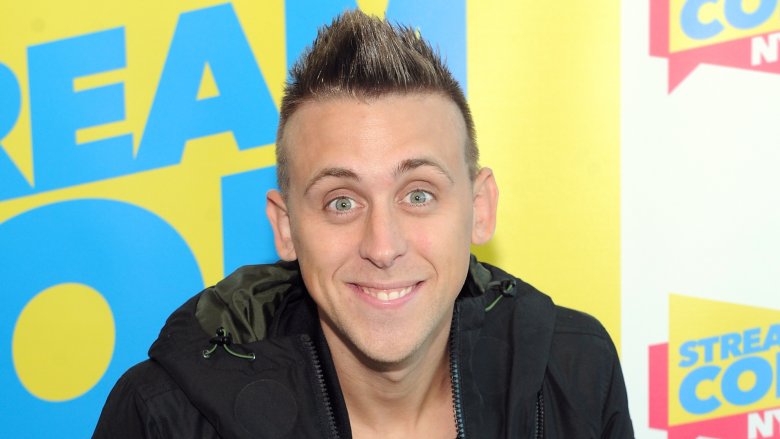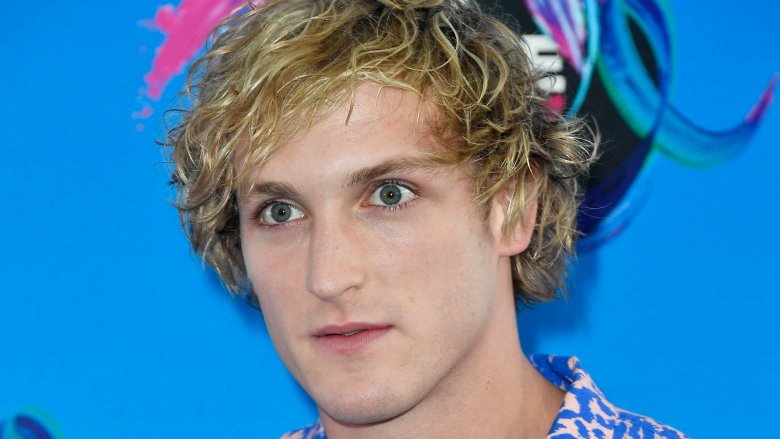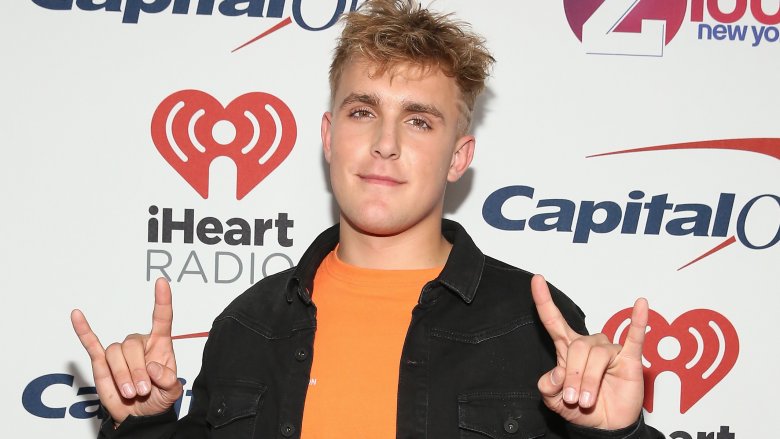YouTubers Who Make A Ton Of Money
When YouTube was launched in 2005, nobody could have predicted it would become a breeding ground for a new generation of millionaires. For most contributors, YouTube is little more than a place to share fun videos or a soapbox to stand on for hot topics, but for a select few, it's a full-time job.
Advertising and sponsorship deals allow content creators with big audiences to turn a profit, and we're not talking loose change. The platform's elite are earning seven-figure salaries, and new influencers are popping up all the time. YouTube has even become a talent mine for mainstream media with stars of the streaming site crossing over to TV and even movies thanks to some seriously lucrative development deals.
Scrambling around to find a webcam and a basic video editing program right now? We don't blame you. In the meantime, let's take a look at some YouTube superstars who are raking in millions.
PewDiePie
Felix Kjellberg (aka PewDiePie) has been known as one of YouTube's biggest star for a while, and it doesn't look like he'll be relinquishing the crown anytime soon. Social Blade figures suggest the Swedish gamer and vlogger will hit 58 million subscribers by the end of 2017, and his already considerable net worth will continue to grow. Forbes estimated that PewDiePie made $15 million in 2016, with two thirds of that coming from ads on his YouTube content.
The rest of his earnings came from various ventures beyond his channel. He became a New York Times bestselling author with This Book Loves You, made bank from a couple of mobile games (Legend of the Brofist and Tuber Simulator) and continues to sell merchandise in huge quantities.
"He would get a check for the rest of his life with his library of content," an industry expert told Forbes. "Even if his viewership declined tremendously, there would still be enough that he would generate a meaningful amount of money."
Having that extensive library of content to fall back on proved to be a lifeline for PewDiePie. The Swede made headlines in 2017 when he lost a deal with Disney over anti-Semitic jokes, which also led to YouTube's paid subscription service, YouTube Red, canceling his series Scare PewDiePie and removing him from the Google Preferred ad program. The drama likely cost him a small fortune, but Forbes predicted PewDiePie would still earn $7 million before the end of the year.
Smosh
Smosh founders Ian Hecox and Anthony Padilla made their debut on YouTube in November 2005, and their comedy channel gradually built a huge audience during the decade that followed. According to Forbes, the Smosh guys made a whopping $8.5 million in 2015, having maximized profits through extra YouTube channels: Smosh Games has proven particularly popular, exceeding 7 million subscribers in 2017.
Their profits were actually down in the financial year 2016, though they still raked in more than your average YouTuber could ever dream of earning. Forbes reported an annual intake of $7 million for Smosh, which was "in part thanks to an entire video series paid for by Schick razors." Their main channel has still been performing well in 2017, with views in the tens of millions every month, according to Social Blade. At the time of this writing, Smosh is considered the fourth most profitable name on YouTube.
All that could change in 2018 because Padilla has retired. "I'm so sad to see this chapter of my life coming to a close, but I will continue to support Ian and wish nothing but the best for him and the brand we created together," he said in a statement. "As I begin this adventure, I am excited to return to a feeling that I felt many years ago: a rush of adrenaline following a new and exciting idea."
The Fine Bros
Brothers Benny and Rafi Fine began uploading to YouTube in 2007, starting out with simple social satire videos before going on to create some of the most popular web series in the site's history. The bulk of their portfolio is made up of their React shows (Kids React, Teens React, Adults React, Elders React and YouTubers React) in which people from different age groups react to everything from Donald Trump to Grand Theft Auto. Their various channels and commercial partnerships made the Fine Brothers $8.5 million richer in 2015, according to Forbes estimates.
2016 was a mixed year for the siblings. They faced immense backlash in February after announcing React World, a program which would allow other YouTubers to make their own reaction videos under the Fine Bros banner—as long as they were willing to pay for it. People accused them of trying to monopolize the reaction video genre, and after watching their subscriber count fall dramatically (they lost 2 million in a single day) they scrapped the idea.
The aforementioned hoopla didn't stop Entertainment One from partnering with Benny and Rafi in late 2016. The production company, along with veteran showrunners Cleve Keller and Dave Noll, inked a deal with Fine Brothers Entertainment to incubate new TV shows (the first of which was Quizzicle) using the FBE audience.
While the brothers' YouTube audience may have diminished slightly, they still have more than 16 million subscribers and are closing in on an incredible 6 billion total views as of this writing.
Lindsey Stirling
Violinist Lindsey Stirling managed to launch a career in the music industry via her YouTube channel, which she created in 2007. Her unique, intricately choreographed performances soon earned her a dedicated online following, and in 2010, she won a spot in the fifth season of America's Got Talent. She exited the show at the quarter-final stage, but the TV exposure allowed her to return to YouTube with an even bigger fan base.
Her 2012 song "Crystallize" (which has been viewed a mind-blowing 181 million times today) became one of the most watched videos on YouTube that year, and in 2013, her collaboration with Pentatonix on a cover of the Imagine Dragons song "Radioactive" won the response of the year award at the first-ever YouTube Music Awards. Forbes estimated that Stirling pulled in a cool $6 million in 2015, with her album, Shatter Me, named the second best dance/electronic release of the year by Billboard (via LA Weekly), outperforming many well-established artists.
The Mormon musician sat down for an interview with The Telegraph in 2017 to discuss her YouTube journey. "My first video attracted 1,000 views, but soon my posts were getting hundreds of thousands of hits," she said. "My song "Crystallise," which is about creating a beauty within yourself, got a million hits in one day. Now I have more than nine million YouTube followers and sold 500,000 concert tickets around the world." As of 2017, her net worth is estimated at $20 million.
Rhett and Link
Childhood friends and self-styled "internetainers" Rhett McLaughlin and Link Neal first brought their brand of wacky comedy to YouTube way back in 2006, when making money from your channel wasn't as straightforward as it is today.
"We had to develop a business model and figure out how to make money off of our YouTube videos, even before there was the YouTube partner program," Link told Parade. "That was in 2007/2008. We were cold-calling or cold-emailing all the businesses that we thought aligned with ideas we had for sketches and music videos, and then writing our own legal contracts to structure some sort of deal, like pay us a little now, and if the video is successful, pay us based on the success of the video."
The duo amassed a huge following with their song parodies and sketches, and later through their daily morning talk show Good Mythical Morning, which welcomed Harry Potter star Daniel Radcliffe as a guest in 2014.
Their multiple YouTube channels (as well as their YouTube Red series Buddy System) have made them two of the most recognizable stars on the platform, and according to Forbes, the pair pulled in $4.5 million in 2015, helped along by sponsorship deals with Gillette, Wendy's, and Toyota. They remained among the top ten earners on YouTube the following year, finishing 2016 with $5 million in their back pockets, according to Social Blade. As of 2017, their net worth is reportedly $6.2 million.
KSI
In 2013, gamer and rapper Olajide Olatunji (better known by his alias KSI) was featured in a gaming edition of Guinness World Records for achieving the "highest margin of victory against the computer on FIFA13," scoring an incredible 190 goals during a single match. His rise to the big leagues hasn't been without controversy, however. Due to alleged sexual harassment at a Eurogamer event in 2012, KSI was banned from attending and was dropped by Microsoft as an Xbox promoter.
The YouTuber's agent responded to the controversy with a statement insisting KSI was "actively working to address any negative impression he has given people with previous content in the past and hopes the industry will see this."
The Brit (who was a millionaire by the age of 21) was estimated to have made a total of $4.5 million in 2015, and he's still making bank in 2017 from his main channel alone. "KSI is able to get an average of 6 million views per day across all his videos cumulatively," NailBuzz reported. "This should be able to generate an estimated revenue of around $11,000 per day ($4 million a year) from advertisements on YouTube." His 2017 net worth is estimated at $12 million.
Lilly Singh
Comedian Lilly Singh got a later start on YouTube than most of the platform's top earners, launching her channel in 2010. The lost time hasn't exactly hampered Singh, whose Punjabi culture provided the main punchline of her content until she decided she needed to widen her audience. "I still have my very Indian parent characters in my videos that still have an accent, my mum still wears a shawl on her head," she said (via the BBC.) "It's just I don't feel the need to frame them just for Indian people because I want my content to be enjoyed universally."
Singh made an estimated $2.5 million in 2015, with some of her income coming from outside of her two YouTube channels. She embarked on a 27-city world tour and made her own behind-the-scenes movie along the way, which helped her earn a place on Forbes richest YouTuber stars list. "Money has always been the result of what I do," she said. "It was never the reason I started."
Her star has continued to rise in the two years since. At the time of this writing, she is pulling in as much as $7.5 million per year, with ValueWalk confirming Singh as the third richest YouTuber. In October 2017, she appeared in the first episode of The Confessional, a virtual reality series from YouTube and Emmy Award-winning VR studio Felix and Paul.
Roman Atwood
Roman Atwood has been walking the fine line between bravery and stupidity on his YouTube channel since 2009. Some of his most popular viral videos are pranks Atwood has pulled on his unsuspecting partner, including a fake cheating confession and a stunt in which he pretends to kill their son by dropping a mannequin dressed in kids' clothing from a balcony. The latter clip was watched 6 million times in just two days in 2014. Viewers were split over whether he'd crossed the line, but the controversy didn't slow him down.
Atwood made an estimated $2.5 million in 2015. That's not exactly chump change, but it's less than half of what he's earning today. According to Forbes, the prankster was the second highest earning YouTuber of 2016 with an income of $8 million. "Atwood's income grew 70% since last year thanks to increased video views, a tour with fellow YouTuber Yousef Erakat, the feature film Natural Born Pranksters, a hefty advance for his upcoming book and a thriving online store selling beanies, pens, sunglasses and more," Forbes reported, adding that he also "banks about $1.5 million for commercials and brand deals—he sealed a big deal to promote Scott Tube-Free Toilet Paper last year."
He is on course to earn a comparable amount in 2017, according to ValueWalk, which ranked Atwood the No. 2 earner PewDiePie.
Rosanna Pansino
There are countless baking channels on YouTube, so to stand out from the crowd, you need a niche. Rosanna Pansino was looking for just that when she joined YouTube in 2010, and she found it with Nerdy Nummies, a geek culture-themed baking show in which she creates all manner of nerdtastic treats.
Pansino parlayed her YouTube fame into a book deal, releasing The Nerdy Nummies Cookbook in 2015 to favorable reviews. It seems all those hours in front of the oven started to pay off for the talented baker, who reportedly earned $2.5 million that year.
It was a level of success the likes of which Pansino could not have envisioned before YouTube. "I've held two to four jobs at a time since the age of 12," she told for Time magazine's Money section in 2017. "If I made $40 babysitting, then I would save 10 percent of it. I put that into my savings account and that was my rainy-day fund." She decided to take a risk and sink every cent of her hard-earned savings into her channel, and it paid off big time. At the time of this writing, Pansino is bringing in $6 million a year, making her the sixth overall richest YouTuber.
Markiplier
YouTuber Markiplier (real name Mark Fischbach) started his gaming channel in 2012 when he was flat broke and in a really bad place. "I'd had a bad breakup, I was fired, I had a tumor in my adrenal gland," he told Forbes. "It was a series of unfortunate events. As I was recovering, I was so desperate to have something that was under my control." YouTube became that something, and despite an early setback (his AdSense account was banned, forcing him to start a new channel from scratch) he became a star in the online gaming community.
A short five years after he turned to YouTube for an outlet, Markiplier was named the most influential gamer by Forbes, beating YouTube's richest content creator, PewDiePie, for the top spot in 2017. This comes on the back of getting signed by Hollywood agency William Morris Endeavor, who arranged Fischbach's 2017 summer tour. The internet star went on the road with a show that was based on improv comedy rather than gaming, and he recently branched out into scripted content with his four-part mystery series Who Killed Markiplier?
"I never have an end goal," he said. "I don't want to be a movie star. I just want to live every day making another cool thing I'm proud of... I get paid way more than I deserve and frankly I'd probably do it for free." Forbes estimated that Fischbach nets around $5.5 million annually.
Grace Helbig
She's been called the queen of YouTube, but Grace Helbig doesn't see herself as royalty. Her boom in popularity came from the fact that she was down-to-earth and friendly on top of being funny in her vlogs, and she was praised early on for the message she was sending to her young female viewers in her makeup and beauty tutorials. "The fashion and style industry takes itself so seriously that you wonder, 'What happens when we stop being so serious about this?'" she told Time magazine. "What would the conversation look like then, and how can we enjoy it?"
Helbig told Slated that she started vlogging on YouTube right after graduating college in 2007, but it wasn't until she moved her popular web series, Daily Grace, from MyDamnChannel to YouTube in 2010 that she became a household name. She made the Forbes 30 Under 30 list in 2014, and by 2015, she was considered a big enough star to make the transition to traditional TV. Unfortunately, her online followers failed to tune in to watch The Grace Helbig Show in the numbers E! was expecting. It slowed Helbig's momentum, but she still has plenty of cash to throw around.
In December 2016, she "shelled out $915,000 for a renovated mid-century bungalow in a hipster-chic neighborhood in Northeast Los Angeles," Variety reported. Her net worth is thought to be around $3 million as of 2017.
Jenna Marbles
Jenna Marbles joined YouTube in 2010, and an early viral video entitled "How to Trick People into Thinking You're Good Looking" quickly propelled her to the forefront of the platform, with more than 5 million views in its first week. At the time, she was working a number of jobs (bartender, go-go dancer, tanning salon) to make rent on her apartment in Massachusetts. "My life was a hot, hot, hot mess," she told The New York Times.
By 2013, she was living in a luxury townhouse in Santa Monica, Calif. worth $1.1 million, funded by the huge cash flow coming from her channel. "I make more money than I need, ever," she said. Marbles, whose real name is Jenna Mourey (Marbles is her dog's name) has potentially earned as much as $6 million to date, according to StatSheep.
Some of that money has come from other ventures, but one that didn't go as Marbles planned was her involvement with the 2016 adaptation of James Patterson's YA novel Maximum Ride. The YouTuber was an executive producer on the low-budget production, which was dubbed "an instantly forgettable affair" by The Hollywood Reporter. Her channel is still going strong, however, with more than 17.5 million subscribers and almost 2.5 billion total views.
Tyler Oakley
When Tyler Oakley uploaded his first video to YouTube from his college dorm in 2007, he had no idea it would go viral and change the course of his life. A decade later, he's one of the few famous YouTubers with name recognition beyond the internet, though he believes that getting thrust into the limelight early was actually a hindrance. "If you do go viral with your first video, I would say that's more of a curse than a blessing, because there's so much expectation of what you then have to keep doing," he told Forbes.
Oakley managed to live up to expectations, earning a strong following in the LGBT community. "It's not all about me being gay," Oakley told the Advocate, explaining that his sexual orientation is "kind of like an underlying theme" rather than the sole focus of his vlogs. In 2017, he broke 8 million subscribers and was included in the Forbes Hollywood 30 Under 30 list. The business mag estimated his earnings at $6 million a year, putting among the top five earners overall.
The deal Oakley signed with the Ellen Digital Network in 2016 looked as though it was going to bring him firmly into the mainstream, but according to The Wrap, he and Ellen DeGeneres (who has been expanding her digital output in recent years) ceased making content together in 2017. He still has fingers in other pies, however, recently starring in the YouTube Red series Escape the Night.
Colleen Ballinger
Colleen Ballinger is best-known for her character, Miranda Sings, who she's been playing on YouTube for the better part of a decade. Miranda was described as "a delusional, narcissistic, yet oddly endearing young woman embarking on a mission to fame" by Elle, who interviewed Ballinger in 2016. She explained that Miranda—who believes she's destined for fame, despite a painfully obvious lack of talent—evolved on YouTube based on comments left by haters. "Whatever haters didn't like, I would do more of it in the next video," Ballinger said.
That tactic worked. By 2016, she was generating around $5 million a year by Forbes estimates, placing her in the upper echelons of YouTube earners. Her stock went up considerably when Netflix announced that it signed a deal with Ballinger to develop the first scripted series created by a YouTube star. All eight episodes of Haters Back Off! (which delves into Miranda Sings' family life as well as her quest for the spotlight) dropped in October 2016, and the show was renewed for a second season before the year was out.
Response to the first season of her Netflix show was mixed, with a respectable average audience score of 69 percent versus a critical approval rating of only 49 percent on Rotten Tomatoes. Reports about her current net worth vary, with NailBuzz claiming it's around $3 million while Gazette Review estimates she's worth as much as $8 million in 2017.
Logan Paul
Logan Paul dropped out of Ohio University when he realized he'd become popular enough on Vine to start taking it seriously as a career. The athletic guy was a natural at pratfalls, and his short-form slapstick comedy made him one of Vine's biggest names, with a whopping 9.4 million followers watching regularly at the time the video sharing service was shut down. His first branded Vine earned him 1,000 bucks back in 2013, according to AdWeek, and by 2015, he was making $200,000 per commercial. "To be honest, I'm worth three times the amount I'm getting paid," he said.
Fast forward to 2017, and Paul's self-determined pay raise seems to have come to fruition. According to Celebrity Net Worth, Paul has $14 mil in the bank thanks to his record-breaking YouTube channel — he surpassed 10 million subscribers in under a year, something that had never been done before. However, the same year ended in disaster for Paul when uploaded a video from his visit to the so-called "suicide forest" in Japan. In a spectacular error in judgement, Paul actually showed what appeared to be a real suicide victim hanging from a tree. He deleted the video, but YouTube responded by removing his channels from Google Preferred, which according to CNN is "a designation that helps advertisers identify YouTube's top-performing channels."
After Paul posted more questionable content, YouTube "temporarily suspended ads on his channels," a move that Time estimated could cost him "between $44,000 and $700,000 a month in ad revenue."
"It hurts, but it's not like I'm drowning," Paul later told Good Morning America. "I try not to live my life thinking about money, cause money doesn't make me happy."
Jake Paul
Logan Paul's little bro, Jake, is also making a name and a small fortune for himself via his action packed YouTube channel. Like his older sibling, JP rose to prominence through his antics on Vine, attracting more than 5 million followers on the now defunct video sharing service. That was enough for Disney to take notice. Jake landed a part on Disney Channel sitcom Bizaardvark in 2015, which not only secured him a generous payday, but helped to increase his influence across the entire social media spectrum.
"As you get more and more popular and start to build a brand name for yourself in the space, you start working with big Fortune 500 companies, merchandising deals, you can tour," he told CNBC. "There are lots of ways to monetize. But if you have millions of fans, and you can convert even five percent of them to pay for something of yours, you are in the seven-figure range."
His net worth took a big hit when the Mouse House cut him loose following some questionable behavior—Jake filled the swimming pool of his $18,000 per month Hollywood rental with furniture and set it ablaze, then mocked the female journalist who came to report on the incident. "Looking back, I can see why everyone was like, 'Yo, this kid sucks,'" he later told The Hollywood Reporter. Despite the damage his antics might have done to his reputation, he's still worth between $3 and $4 million as of 2017.
RiceGum
When RiceGum (real name Bryan Le) joined YouTube in 2012, he was a 15-year-old gamer specializing in Call of Duty. It wasn't until 2015 that he became well-known outside of the YouTube gaming community when his video "These Kids Must Be Stopped!" started gaining attention. The clip (calling out underage users of the app Musical.ly for lip-syncing to explicit lyrics) was watched 11 millions times over the the next 12 months, and in that time, RiceGum became embroiled in a number of YouTube beefs.
His back-and-forth with Jacob Sartorius (one of the kids he claimed needed to be stopped in his viral video) grew his subscriber base considerably, with his diss track about the young social media star getting as many views as the original video. The success encouraged RiceGum to carry on roasting, and the more popular (and more wealthy) he became, the higher the production quality of his diss tracks. He's been hard on everyone from Jake Paul to iDubbbzTV.
By 2017, RiceGum had more than 8 million subscribers and had earned enough to move to the Hollywood Hills, renting a $12.5 million mansion formerly occupied by YouTube alum Justin Bieber. The rent (which he splits with roomies/fellow influencers FaZe Banks, Alissa Violet and his rumored girlfriend Sommer Ray) is said to be $47,000, but Rice can afford it. According to NailBuzz, he's making $6,000 a day from ad revenue, which keeps that huge roof over his head and funds his infamous spending sprees.
Alex Wassabi
Youtubers Roi Fabito and Alex Burriss grew up in the same North Carolina neighborhood and started making videos together when they were still in school. They registered a joint YouTube channel in 2006, eventually deciding on the name Wassabi Productions for their brand of comedy, which involved lip-sync parodies and wacky dance numbers. They became increasingly popular in the years that followed and were known to pull in huge viewer numbers on occasion—their version of Carly Rae Jepsen's "Call Me Maybe" has been watched more than 125 million times.
In early 2016, Fabito decided to quit Wassabi Productions to take some down time and focus more on his solo stuff, leaving Burriss in charge. The channel continued to grow in his absence, and Wassabi Productions is closing in on 10 millions subscribers as 2018 approaches. Burriss even branched out into movies, with a cameo role in high school comedy The Duff (2015) and an appearance in Tyler Perry's Boo 2! A Madea Halloween (2017).
According to NailBuzz, Burriss (whose known as Alex Wassabi to his fans) had a net worth in 2017 of about $5 million, and the Wassabi Productions channel (of which he's now the sole beneficiary) is growing by an average of 6,000 subscribers daily and pulling in as much as $5,400 every 24 hours.
Fabito's channel, Guava Juice, has become pretty successful too. NailBuzz reports his personal net worth in 2017 in the region of $3 million.

